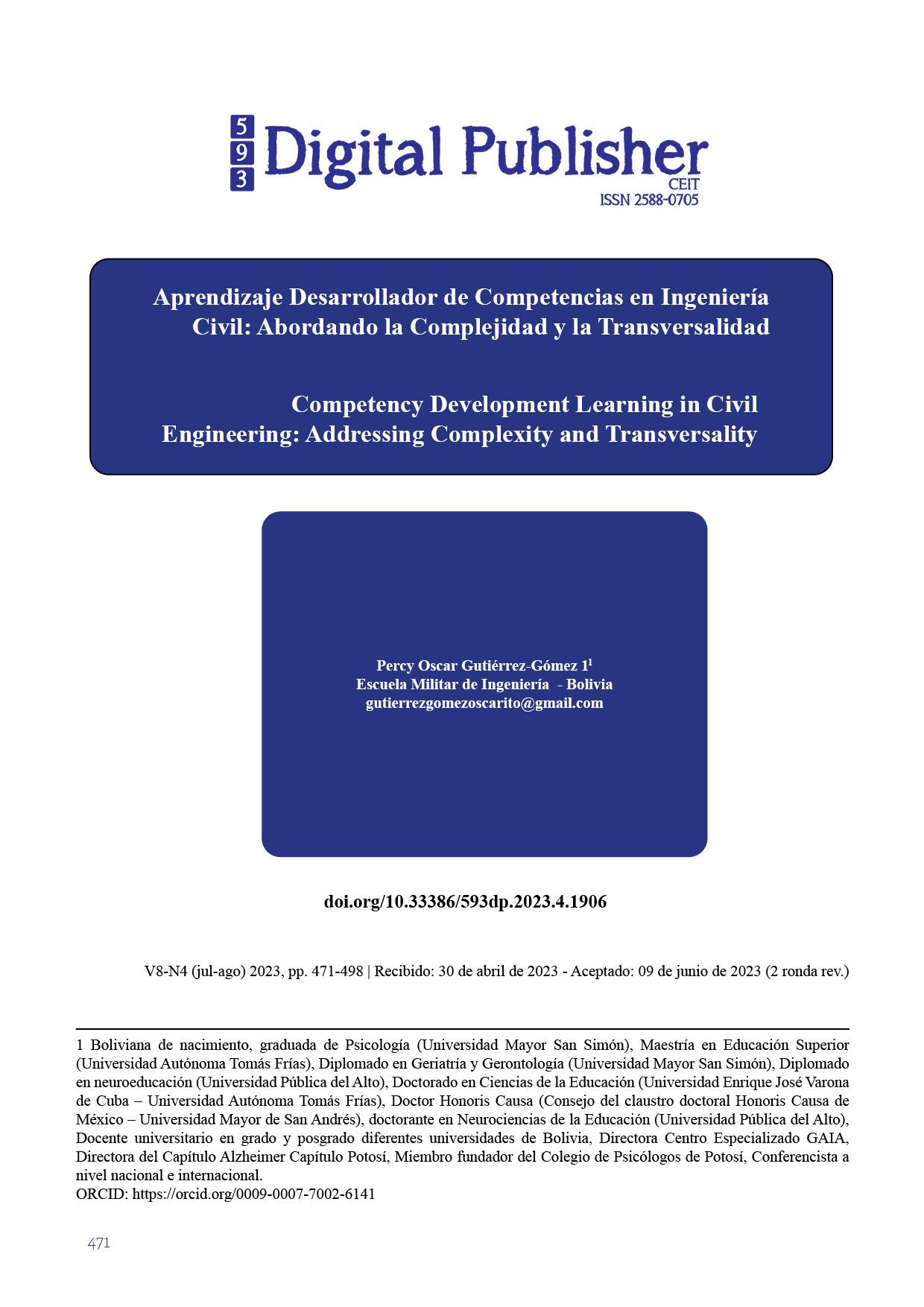Competency Development Learning in Civil Engineering: Addressing Complexity and Transversality
Main Article Content
Abstract
Civil engineering is a complex and transversal discipline that covers a wide variety of areas, from planning and design to construction and maintenance of infrastructures and buildings. To develop skills and competencies in this area, it is necessary to address this complexity and transversality effectively.
The theories of developer learning and the necessary skills for the training of civil engineers in a complex and changing world are reviewed. In addition, pedagogical strategies are discussed that promote learning that develops competencies in civil engineering, such as project-based teaching, active learning, and collaborative work.
The article addresses the importance of developing skills in civil engineering students to face the complex and transversal challenges of the profession. Key concepts such as complex problem solving, teamwork, and effective communication are discussed, and how these concepts are applied in civil engineering education is explored.
Academic and professional literature on the subject is reviewed, presenting relevant authors, books, and years in the field. The importance of integrating complexity and transversality in the training of civil engineers is highlighted, and pedagogical approaches and teaching strategies used to promote skills-developing learning are presented.
The importance of addressing complexity and transversality in the training of civil engineers through skills development learning is highlighted. Key concepts, teaching strategies, and educational tools used are highlighted, as well as the results and challenges of implementing this approach. The ultimate goal is to prepare students to meet the current and future challenges of civil engineering competently and effectively.
Downloads
Article Details

This work is licensed under a Creative Commons Attribution-NonCommercial-ShareAlike 4.0 International License.
1. Derechos de autor
Las obras que se publican en 593 Digital Publisher CEIT están sujetas a los siguientes términos:
1.1. 593 Digital Publisher CEIT, conserva los derechos patrimoniales (copyright) de las obras publicadas, favorece y permite la reutilización de las mismas bajo la licencia Licencia Creative Commons 4.0 de Reconocimiento-NoComercial-CompartirIgual 4.0, por lo cual se pueden copiar, usar, difundir, transmitir y exponer públicamente, siempre que:
1.1.a. Se cite la autoría y fuente original de su publicación (revista, editorial, URL).
1.1.b. No se usen para fines comerciales u onerosos.
1.1.c. Se mencione la existencia y especificaciones de esta licencia de uso.
References
Ackoff R. (1974), "Redesigning the Future: A Systems Approach to Societal Problems". Editorial Wiley
Aguaded J.I. (2015). "Ingeniería y competencias transversales en la educación superior". Revista Interuniversitaria de Formación del Profesorado.
Allen E y Lano J. (2019), “Fundamentals of Building Construction: Materials and Methods" Editorial Wiley.
Batty M. (2005) "Cities and Complexity: Understanding Cities with Cellular Automata, Agent-Based Models, and Fractals". Editorial Springer Berlin Heidelberg.
Barrows H. y Tamblyn R. (1980), “Problem-Based Learning / An Approach to Medical Education”. Editorial Springer Publishing Company
Bertalanffy L, (1968), “General System Theory / Foundations, Development, Applications” Editorial G. Brazilier
Biggs J. (2011). "Teaching for Quality Learning at University: What the Student Does". Editorial Mc. Graw Hill
Boyatzis R. (1980), “Opportunities for Counselors from the Competency Assessment Movement”. Editorial Journal of Counseling & Development
Boyatzis R. y Goleman D. (2000), “Clustering Competence in Emotional Intelligence: Insights from the Emotional Competencie Inventory (ECI). EICONSORTIUM. https://www.eiconsortium.org/
Bowen W. (2013)."Higher Education in the Digital Age". Editorial IGI Global
Capra F. (1996), "La trama de la vida: Una nueva perspectiva de los sistemas vivos". Editorial Anagrama S.A.
Crawley E. et. al. (2007), “Rethinking Engineering Education, The CDIO Approach”, Editorial Springer.
Dewey J. (1910). "How We Think: A Restatement of the Relation of Reflective Thinking to the Educative Process". Library of Alexandria
Dee Fink L. (2013). "Creating Significant Learning Experiences: An Integrated Approach to Designing College Courses". Editorial Jossey - Bass
Felder R. y Brent R. (2009). "Active Learning and Engagement Strategies in Engineering Education". Editorial: Wiley
Gee J.P. (2007). "What Video Games Have to Teach Us About Learning and Literacy". Palgrave Macmillan
Goldberg D. (2017). "The Design of Innovation: Lessons from and for Competent Genetic Algorithms". Kluwer Academic Publishers101 Philip Drive Assinippi Park Norwell, MA, United States
Instituto de Tecnología de Massachusetts (2023). “MIT Professional Education: Programas y Cursos Online”. https://professionalprograms.mit.edu/es/
Jonassen D. (2004). "Learning to Solve Problems: A Handbook for Designing Problem-Solving Learning Environments". Editorial Routledge
Kauffman S. (1993), "The Origins of Order: Self-Organization and Selection in Evolution" Editorial Osford University Press
Kegan R. (1982). "The Evolving Self: Problem and Process in Human Development". Harvard University Press
Khurmi R y Gupta J. (2019)"Civil Engineering: Conventional and Objective Type" Editorial S. Chand Limited
Klein J. (1990), "Interdisciplinarity: History, Theory, and Practice”. Editorial Wayne State University Press
Klein J. y Newell W. (1997), "Advancing Interdisciplinary Studies", Editorial Jerry Gaff and James Ratcliff
Kolb D. (2014), “Experience as the Source of Learning and Development”. Editorial Pearson Education.
Quadrado J.C. (2017), "Sustainability in Engineering Design and Construction". Editorial CRC Press
Oakes W. y Crumpton-Young L. (2010) - "Engineering for Sustainable Community Development” Editorial
Senge P. (1990), "La quinta disciplina: El arte y la práctica de la organización abierta al aprendizaje" Editorial Granica, S.A.
Laurillard D. (2013). "Rethinking University Teaching: A Conversational Framework for the Effective Use of Learning Technologies". Editorial Routledge.
Lefebvre J.P. (1990), “Les Professeurs Français des Missions Universitaires au Bresil”. Cahiers du Bresil Contemporain No.12.
Mayer R. (2009). "Multimedia Learning", Cambridge University Press
McClelland D. (1989), “Estudio de la motivación humana”. Editorial Narcea
Meadows D. (1972), "Límites al crecimiento: el informe del Club de Roma sobre los límites del crecimiento". Editorial Fondo de Cultura Económica
Morin E. (2006), "El Método". Editorial Cátedra
Newell W y Mintzes J. (2011), "Interdisciplinary Education in the Age of Assessment”. Editorial University of California Press
Serra L. et.al. (2016). "Competency-Based Education in Three Pilot Programs: Examining the Experiences of Students and Faculty". Editorial: Stylus Publishing
UNESCO (2017), “Culture Urban Future” Editorial UNESCO Paris (Francia)
Universidad de Stanford (2023). “Programa de Ingeniería Civil y Ambiental”. https://online.stanford.edu/
Universidad de Tecnología de Delft (2023). “Programa de Ingeniería Civil”. https://academia-lab.com/enciclopedia/universidad-tecnologica-de-delft/
Universidad de California, Berkeley (2023) “Programa de Ingeniería Civil y Ambiental”. https://ce.berkeley.edu/
Universidad Técnica de Múnich (TUM) (2023). “Programa de Ingeniería Civil”. https://www.tum.de/
Universidad Tecnológica de Queensland en Australia (2023). “Programa de Ingeniería Civil y Ambiental”. https://www.qut.edu.au/
Wagner T. (2012) "Creating Innovators: The Making of Young People Who Will Change the World" Editorial Scribner
Weingart P. y Stehr N. (2000), "Practising Interdisciplinarity”. Editorial University of Toronto Press
Weiss E. (1997). "A Methodical System for Engineers: The Engineering Method in Engineering Design".


